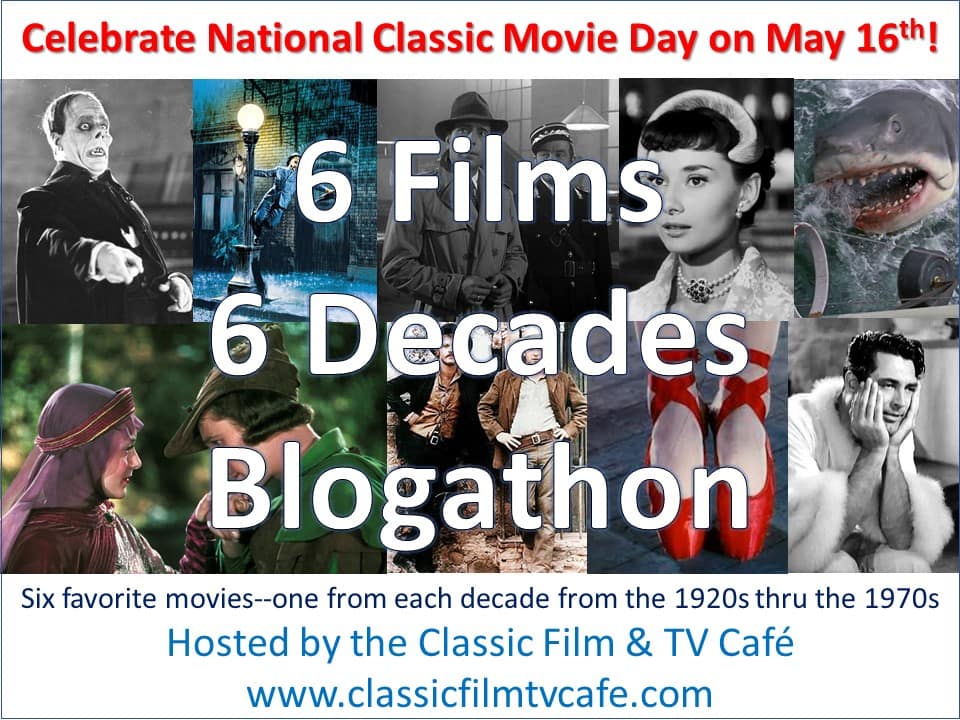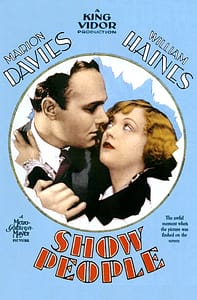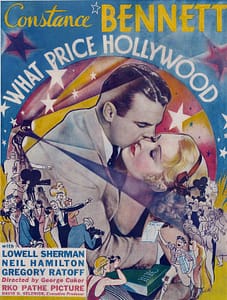
Anyone who has made a list before knows the labor of love required to whittle down dozens or hundreds of your favorites to select just a few. Instead of picking one single favorite film from each decade, sometimes I wished I could have made a ten top or twenty for each decade. As I struggled to choose which movie would win the battle royal of favorites for each decade I got an idea: what if I picked a favorite type of film or genre for my list?
I decided to focus my picks on films that examine stars and their audiences, a subject that has always fascinated me. What better way to celebrate National Classic Movie Day than to highlight films that focus on the performers from various forms of entertainment that have made classic films so great? The films below tackle the influence and power that Hollywood actors, vaudeville dancers, local radio stars, and national television anchors exerts over their audience, for better and worse, and in turn the personal issues that come with their star power.
This post is part of Classic Film and TV Cafe‘s Six Films—Six Decades Blogathon for National Classic Movie Day. To view other bloggers’ favorites from six decades of classic film, visit the blogathon’s main page.
1920s: Show People (1928)
For the majority of the public, silent films are chaotic farces filled with frenetic sped-up comic action. Show People does a wonderful job of exposing more casual viewers to the great diversity of silent cinema. The film showcases several genres of silent cinema, from melodrama to slapstick comedy. Show People also includes several famous silent star cameos from Charlie Chaplin to William S. Hart and even the real-life Marion Davies!
Marion Davies plays a country girl who comes from Georgia to Hollywood to become a great serious star, only to find herself stuck at the bottom of the ladder in a Keystone-like comedy troupe. The film includes Marion Davies’ best comedic work and captures the magic behind silent era films and filmmaking.
1930s: What Price Hollywood? (1932)
What Price Hollywood? features Constance Bennett as a waitress discovered by a spiraling alcoholic movie director who helps her become a Hollywood star. If the story sounds familiar, you’re not the first one to think so. RKO considered filing a plagiarism suit against David Selznick when his production studio produced A Star is Born in 1937 for lifting numerous plot points from this Cukor-directed Pre-Code film.
While the multiple versions of A Star is Born unfortunately overshadow What Price Hollywood?, it’s a film worthy of remembrance. What Price Hollywood? leans into its pre-code style to explore the dark side of Hollywood. Bennett gives a wonderful turn as the lead and Lowell Sherman gives a great performance as her friend and director. Excluding a tacky, rushed ending, What Price Hollywood? wonderfully sinks its teeth into Hollywood’s star-making factory that all too often abandons its actors and filmmakers once it no longer needs them to turn a profit.
1940s: Dance, Girl, Dance (1940)
While the film centers around a dancer, Dorothy Arzner uses dance to tackle issues of sexism and the male gaze inherent in cinema and various forms of entertainment. The film follows two dancers in a traveling troupe. Judy, played by Maureen O’Hara, studies and trains hard in hopes to become a serious ballerina. Bubbles, played by Lucille Ball, relies on her sexuality to get ahead in the business and to support her lush lifestyle. After their dance troupe’s elderly leader dies in an accident, both women become intertwined in a love triangle with a wealthy recent divorcee and end up working in a burlesque show where Bubbles becomes the headlining act.
While criticizing viewers and the star system for objectifying women, Arzner never looks down on Bubbles’ decision to use her sex appeal even if she acts as a foil for the more artistically minded Judy. O’Hara’s famous speech to a boisterous vaudeville audience filled with ogling men is one of the most fascinating indictments of Hollywood’s exploitation of women’s sexuality coming at a time when sexism was rarely explicitly discussed in popular entertainment.
1950s: A Face in the Crowd (1957)
Andy Griffith is best known for his calm and friendly persona in his years of television. In A Face in the Crowd, however, he gives one of the best, unhinged debut performances in all of classic film. Patricia O’Neal plays a radio journalist, Marcia Jeffires, who stumbles upon Griffith’s charismatic drifter Larry Rhodes while doing a story in a local Arkansas jail. Noticing Rhodes’ natural talent and charm, Neal turns him into one of the nation’s most popular radio and television entertainers, falling in love with him along the way.
Rhodes has different plans. Drunken with his own power over his audience, he starts a line of affairs and attempts to shape politics through his contrived TV persona. A Face in the Crowd is a rare film that becomes more relevant and timeless with every passing year, capturing the insanity and hypocrisy of manipulative media personalities willing to cause political havoc and real-life damage for their own profit.
1960s: Elmer Gantry (1960)
In an Academy Award-winning performance, Burt Lancaster plays the titular character, a traveling conman who joins a touring evangelist’s revival roadshow after being drawn to its attractive preacher Sharon Falconer, played by Jean Simmons. Putting on an act as a pious reformed sinner, Gantry captivates the roadshow’s audiences, builds up Falconer’s power and influence in the religious community, and steals Falconer’s heart. Near the pinnacle of their success, a scandal from Gantry’s past threatens to end their newfound successful reputation and budding relationship.
Elmer Gantry deals with traveling revival roadshows instead of dancers, television personas, and Hollywood starlets but the film’s genius is that it treats religion as a show business. Lancaster’s Gantry is not a preacher but an entertainer, putting on an act to gain influence over and money from religious Americans. Elmer Gantry is an engaging and fascinating examination of Americans’ willingness to follow charisma whether it’s in a movie theater watching our favorite actors or in the pews.
1970s: Network (1976)
Featuring an all-star cast of Faye Dunaway, William Holden, and Peter Finch and written by frequent TV writer Paddy Chayefsky, Network follows the Union Broadcasting System TV network’s fall from a traditional news-first organization to a station that merely seeks to gain the most viewers as possible through whatever means necessary. After longtime newscaster Howard Beale receives the news that he is being fired for his low ratings, he breaks down on live television into an angry diatribe: “I’m mad as hell and I can’t take it anymore!”. After Beale’s ratings fly through the roof after his expletive-laced rant over live TV, the station keeps him working to exploit Beale’s obviously deteriorating mental health to cash in on his new-founded popularity with viewers.
Like A Face in the Crowd, Network is a work of prophecy, criticizing news organizations and media creators for willingly lying to and manipulating their viewers in order to increase their own financial standing, something that remains increasingly popular in the social media age. Network‘s cynical take on the entertainment industry’s power over the everyday consumer shamelessly calls out the damaging practice of news organizations masking commodified misinformation as journalism.







I really debated about whether or not to include Show People on my list, because it is a terrific film in every way. I decided against it, so I’m glad to see it included on yours.
I’ve never seen Dance Girl Dance, and I’ll be looking for it. Thanks in advance for your recommendation. 🙂
The 20s is so full of favorites it is hard to narrow it down to just one!
Just love seeing A Face in the Crowd and Network together on your list. Once you see Andy Griffith as Lonesome Rhodes after seeing him as Ben Matlock and Andy Taylor on TV, you realize he had more range than you imagined. Both are fantastic films that unfortunately turned out to be all too prophetic.